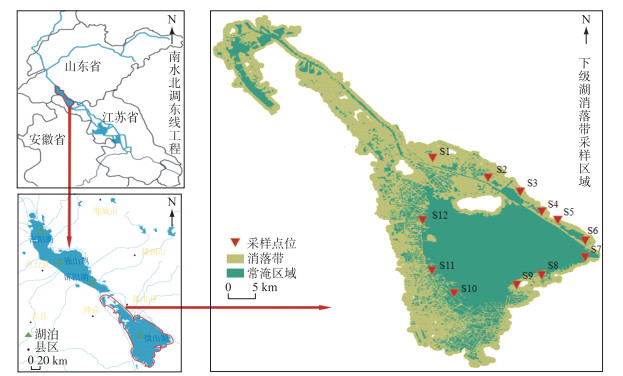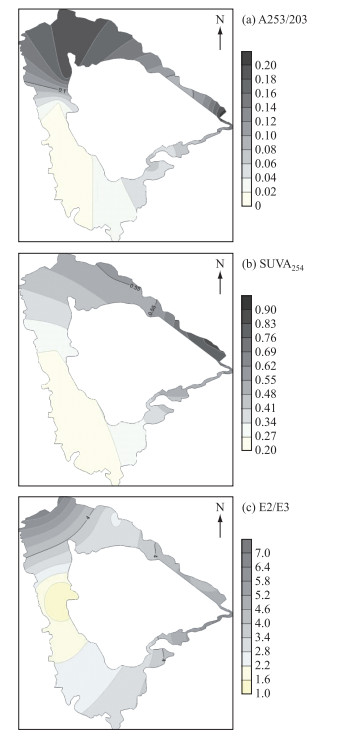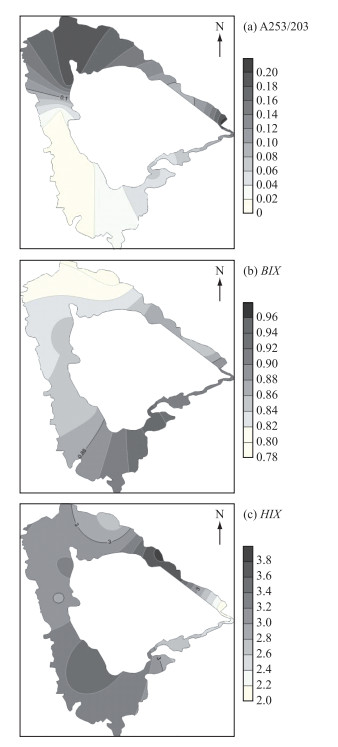(2: 山东建筑大学资源与环境创新研究院, 济南 250101)
(2: Resources and Environment Innovation Institute, Shandong Jianzhu University, Jinan 250101, P.R. China)
磷是影响水体初级生产力的主要营养元素,是导致水体富营养化发生的主要限制因子[1-3]。水体底泥磷的释放潜力(即活性)取决于磷在底泥中的赋存形态。当前对于南四湖湖泊及其消落带底泥磷污染研究大多集中在总磷(TP)及无机磷(IP)上,而关于底泥有机磷(OP)的研究较少。OP是底泥中磷及有机质的重要组分,近年来的研究发现底泥中有机磷的含量、形态、生物有效性等方面在水体磷循环中起着重要的作用[4-6]。底泥中有机磷的释放主要受有机磷形态和有机磷矿化作用的影响[7],湖泊底泥释放溶解性有机磷(DOP)占总磷比重较高,可转化为溶解性无机磷(SRP)而被生物利用[8],刘哲哲等[9]在研究湖泊沉积物有机磷释放特征中发现与SRP相比,DOP释放量较大,占溶解性总磷(DTP)总释放量的47% ~77%,释放风险较高,湖泊水质下降风险高,容易导致湖泊富营养化。Ni等在研究沉积物OP组成对湖泊营养状况响应时发现,沉积物OP可能较TP更能反映湖泊营养状况[10]。
消落带是由于湖泊或水库水位涨落而使水域周边土地周期性被淹没或落干而形成的特殊区域,消落带内水陆物质交换强烈对水体磷的循环有着重要影响[11]。水位周期涨落会改变消落带底泥氧化还原电位、pH、矿物物理性质、微生物群落活性及结构等[12-13],进而影响消落带磷的释放、迁移和转化。南四湖作为南水北调东线工程最大的调蓄湖泊,由于长期的外源输入和底泥内源磷释放导致自2013年10月东线工程投入运营以来,反季节调水期间湖区频繁出现总磷升高现象[14]。此前研究揭示了南四湖消落带底泥中磷的形态分布特征、影响因素及释放风险[15],然而目前针对南四湖消落带底泥有机磷形态及分布特征尚鲜有报道。因此,本文进一步调研分析南四湖消落带底泥有机磷形态及分布,探讨南四湖消落带不同形态有机磷的迁移转化规律,以期为控制湖泊水体富营养化提供数据支撑。
1 材料与方法 1.1 研究区域概况南四湖位于山东省西南部(34°37′~35°20′N,116°34′~117°21′E),是南阳湖、独山湖、昭阳湖、微山湖四个湖泊的总称,是我国第六大淡水湖泊,也是南水北调东线工程最大的调蓄湖泊[16-17]。南四湖总流域面积31700 km2,湖区面积1266 km2,蓄水量19.3亿m3,湖区平均水深不足2 m。二级坝泵站将南四湖分成上、下级湖,北侧为上级湖,南侧为下级湖[18],其中上级湖占全湖面积的47.5%,承担着88.4% 流域面积的来水;下级湖占全湖面积的52.5%,仅承担11.6% 流域面积的来水。自然情况下,水流从上级湖经二级坝泄水进入下级湖,再由不牢河和韩庄运河进入中运河[19]。但南水北调输水与自然水流方向相反,由下级湖南端进入,经二级坝泵站,在上级湖北端进入梁济运河。调水期间,由于南四湖的调蓄功能由下级湖——微山湖实现,所以其消落带主要分布在微山湖区域[20],当水位增加0.5~1.0 m时,反复淹水形成消落带面积最多达30余km2。本研究区域位于南四湖的下级湖(微山湖),消落带底泥采样点位置及湖泊水体基本理化性质信息详见图 1和表 1。

|
图 1 南四湖消落带采样点示意 Fig.1 Sampling points in the fluctuation zone of Lake Nansi |
| 表 1 采样点位的水体理化性质 Tab. 1 Physical and chemical properties of the water at the sampling points |
2021年8月于南四湖下级湖消落带12个点位(图 1)采集表层20 cm土壤。为避免数据偶然性,增加样品在区域内的代表性,每个采样点使用柱状采泥器取3个平行样,现场将底泥均匀混合后采用四分法将样品储于聚乙烯密封袋中,随后将底泥样品置于便携冰箱中运至实验室。底泥样品经自然风干,去除石子、壳类以及腐根等杂物,研磨过100 μm筛后用于各项指标检测。
1.3 样品分析 1.3.1 底泥理化性质测定底泥pH使用哈希便携式测量仪测定,底泥有机质(OM)的含量通过550℃条件下样品灼烧6 h得到的烧失量(LOI)计算[21]。采用Ruban等[22-23]在欧洲标准测试委员会框架下发展的SMT分析方法测定底泥TP、IP,最后通过TP与IP相减获得OP含量。
1.3.2 底泥有机磷分级提取采用改进后的Hedley[24]连续分级提取法分级提取底泥有机磷,详细步骤见图 2。该提取方法可以将底泥中的磷分为水提取态磷(H2O-P)、碳酸氢钠提取态磷(NaHCO3-P)、铁铝结合态磷(NaOH-P)、钙结合态磷(HCl-P)和残渣态磷(Residual-P)。其中提取液中的总磷含量(TPt)采用过硫酸钾氧化消解-钼锑抗分光光度法测定,无机磷含量(IPi)直接采用钼锑抗分光光度法测定,提取液有机磷含量(OPo)由TPt与IPi相减得到。

|
图 2 改进Hedley有机磷连续提取流程 Fig.2 Flowchart of improved Hedley organophosphorus continuous extraction |
利用紫外可见分光光度计(UV-3200,MAPADA)测量采集底泥DOM的紫外可见吸收光谱,将底泥样品DOM提取液加入1 cm石英比色皿中,测量波长范围为200~700 nm,间隔为1 nm,中速扫描,Milli-Q超纯水作为空白对照。经散射校正的波长λ处吸收系数计算方法如下[25-26]:
| $ a^*(\lambda)=2.303 \cdot D(\lambda) / r $ | (1) |
| $ a(\lambda)=a^*(\lambda)-a^*(700) \cdot \lambda / 700 $ | (2) |
式中,λ为波长(nm);a*(λ)和a(λ)分别为未经散射校正和经过散射校正过后的波长λ处的吸收系数(m-1);D(λ)为波长λ处的吸光度;r为光程路径(m)。本研究中E2/E3指250 nm和365 nm处的紫外吸光度之比,其值与相对分子质量大小呈反比[27-28]。SUVA254指样品在波长为254 nm时,紫外吸光度乘100后与溶解性有机碳(DOC)浓度的比值,用来表征水体中天然有机质亲水性[29]。
利用荧光分光光度计(F-7100,Hitachi)测定采集底泥DOM的三维荧光光谱,将底泥样品DOM提取液加入1 cm石英比色皿中,扫描速度为2400 nm/min,PMT电压为400 V,扫描光谱波长范围为激发波长Ex 200~450 nm,发射波长Em 250~600 nm,狭缝跨度均为5 nm;以Milli-Q超纯水进行空白样测定,样品三维荧光光谱扣除空白样品的光谱信号后计算荧光强度(FI)、腐质化指数(HIX)和自生源指数(BIX)。荧光指数FI定义为激发波长为370 nm时,发射波长Em为450 nm与500 nm处荧光强度比值[30];HIX指数是激发波长为255 nm时,发射波长Em在435~480 nm荧光强度积分值和300~345 nm荧光强度积分值之比;BIX指数为激发波长Ex为310 nm时,发射波长Em为380 nm与430 nm处荧光强度比值[31-32]。
1.4 数据统计与分析方法本研究利用ArcGis10.2软件绘制采样点位置图,数据经Excel 2016处理后使用Origin 2021绘图,利用Surfer软件绘制消落带各指数的等直线图,使用IBM SPSS Statistics 26软件对样品参数进行Pearson相关性分析,R语言软件包进行主成分分析。
2 结果与讨论 2.1 消落带底泥理化特性南四湖消落带底泥pH在7.76~8.54之间,总体呈弱碱性,平均值为8.09(表 2),查阅2018年山东省及江苏省土壤类型图,南四湖底泥主要母质类型为潮土、砂姜黑土及褐土,底泥易出现石灰反应造成底泥呈弱碱性。消落带底泥有机质(OM)含量范围为4.87% ~11.09%,均值为7.51% (表 2),表现为东岸的潮土(9.47%)和砂姜黑土(8.74%)大于西岸(8.46%)及南岸(6.56%)的褐土。南四湖西岸消落带植物相对密集,夏季水生植物多,微生物种类丰富可能是导致西岸(8.46%)褐土有机质含量高于南岸(6.56%)的重要原因。本研究中南四湖消落带底泥有机质平均含量(7.51%)高于三峡库区、巢湖以及洪泽湖底泥[33-35],可能是因为南四湖消落带水位变化小,植物覆盖率高,当消落带淹水后植物逐渐腐败,在微生物的作用下植物残体成为新的有机质来源,导致南四湖消落带底泥有机质含量高。此前研究表明南四湖消落带底泥磷污染处于中度污染水平,释放风险大[15]。2021年南四湖消落带底泥TP含量范围为379.25~859.50 mg/kg,平均值为679.90 mg/kg(表 2)。对比2019年南四湖消落带底泥磷(745.37 mg/kg)含量略有降低,磷污染情况出现好转但仍处于中度污染水平。
| 表 2 采样点底泥理化性质 Tab. 2 Physicochemical properties of sediment at sampling points |
水提取态有机磷(H2O-Po)是一种极易矿化和迁移的有机磷形态,容易被环境因子所影响,相较于其他形态的有机磷更容易释放进入上覆水体[36],导致水体富营养化风险更大。南四湖消落带底泥样品中有机磷各形态含量分布见图 3。南四湖消落带底泥H2O-Po含量范围为1.10~8.78 mg/kg,平均值为4.39 mg/kg。消落带底泥H2O-Po含量表现为西岸(7.26 mg/kg)的褐土大于南岸(3.50 mg/kg)的褐土以及东岸的潮土(2.89 mg/kg)和砂姜黑土(3.55 mg/kg)。碳酸氢钠提取态有机磷主要指NaHCO3溶液提取的核酸、磷脂类、磷糖类等含磷化合物,是底泥中活性较强的一种磷形态,极易被矿化分解,生成小分子化合物或磷酸盐进而释放到间隙水[37],且能够被水生生物直接利用。南四湖消落带底泥NaHCO3-Po含量范围为3.77~25.90 mg/kg,平均值为11.86 mg/kg。消落带底泥NaHCO3-Po含量表现为西岸的褐土(24.20 mg/kg)远远大于南岸的褐土(6.61 mg/kg)以及东岸的潮土(7.57 mg/kg)和砂姜黑土(7.07 mg/kg)。

|
图 3 南四湖消落带底泥各形态OP含量空间分布 Fig.3 Distribution of OP content of various forms in bottom mud of the water-level-fluctuation zone of Lake Nansi |
铁/铝结合态有机磷(NaOH-Po)主要包括中活性的富里酸结合态有机磷和非活性的胡敏酸结合态有机磷[38],其活性相对较低。南四湖消落带底泥NaOH-Po含量范围为7.85~28.20 mg/kg,平均值为15.22 mg/kg。消落带底泥NaOH-Po含量表现为东岸的潮土(17.85 mg/kg)和砂姜黑土(17.59 mg/kg)大于南岸(10.93 mg/kg)及西岸(12.65 mg/kg)的褐土。钙结合态有机磷(HCl-Po)主要指与自生磷灰石、沉积碳酸钙以及生物骨骼等含磷矿物有关的沉积磷形态[39],其稳定性高,不易向水体中释放。南四湖消落带底泥中HCl-Po含量范围为8.25~56.31 mg/kg,平均值为33.07 mg/kg。消落带底泥HCl-Po含量表现为西岸(51.83 mg/kg)的褐土大于南岸的褐土(614.60 mg/kg)以及东岸的潮土(39.35 mg/kg)和砂姜黑土(27.46 mg/kg)。残渣态有机磷(Residual-Po)主要成分为植酸态磷,是一种不易被矿化和降解的稳定性较高的非生物可利用有机磷。南四湖消落带底泥Residual-Po含量范围为64.32~229.25 mg/kg,平均值为134.01 mg/kg。消落带底泥Residual-Po含量表现为东岸的潮土(150.92 mg/kg)和砂姜黑土(134.25 mg/kg)大于南岸(131.11 mg/kg)及西岸(113.10 mg/kg)的褐土。
南四湖消落带底泥各形态有机磷含量差距较大,底泥有机磷中两种活性有机磷(H2O-Po和NaHCO3-Po)占比分别为2.22% 和5.97%,两种稳定性较高的有机磷(NaOH-Po和HCl-Po)占比分别为7.62% 和16.61%。Zhu等[36]对滇池沉积物的研究发现,大约有70% NaOH-Po可以被酶解成无机磷而被水生生物利用,南四湖消落带NaOH-Po含量在空间表现相对一致,向水体释放NaOH-Po风险基本一致。HCl-Po含量在底泥有机磷占比高达16.61%,同时Residual-Po含量在总有机磷中占比也达到67.58%,虽然两者在底泥有机磷中占比达到84.19%,但因为两者具有稳定性高、不易释放的特点所以引起水体富营养化的风险较低。南四湖消落带底泥活性有机磷含量(H2O-Po 4.39 mg/kg、NaHCO3-Po 11.86 mg/kg)高于三峡库区澎溪河流域[40]消落带底泥有机磷含量(H2O-Po 0.97 mg/kg、NaHCO3-Po 2.75 mg/kg),而低于洱海[41]表层沉积物有机磷含量(H2O-Po 3.68 mg/kg、NaHCO3-Po 40.60 mg/kg),表明南四湖消落带底泥有机磷释放风险高于三峡库区澎溪河流域,但低于洱海。由于南四湖消落带西岸活性有机磷含量(31.46 mg/kg)高于东岸(10.54 mg/kg)及南岸(10.11 mg/kg),当底泥处于淹没状态时,底泥和水界面的相互作用强烈,活性有机磷易被分解为小分子化合物或磷酸盐进而释放到上覆水体中[42],表明西岸有机磷释放风险高于东岸及南岸。
2.3 消落带底泥DOM光谱特征分析DOP是溶解性有机质(DOM)的重要组分,Long等通过实验发现DOM和磷吸附解吸过程密切相关,是影响沉积物磷释放的重要机制[43]。紫外可见光谱技术和三维荧光光谱技术可用于表征有机分子结构组成和稳定性,并从侧面反应有机磷结构及稳定性的差异。已有研究发现底泥DOM苯环上羟基、羧基和羰基等官能团结构的变化会影响底泥磷的释放,不同点位底泥DOM的紫外特征参数值差异可用来表征底泥有机磷释放速率和释放量的差异[9]。
2.3.1 消落带底泥DOM紫外光谱指数变化特征A253/203可以用来预测芳香环取代基的种类以及取代程度,A253/A203值越大,芳香环上取代基(羰基、羧基、羟基和酯基)越多,反之则以脂肪链为主[44]。SUVA254不仅可以表征天然有机质的亲水性,还可以反映芳香碳在有机质中的丰富度,该值越高,物质的芳香性越强,腐殖化程度越高,微生物可利用性越弱[45]。南四湖消落带底泥DOM的A253/203和SUVA254变化范围分别为0.02~0.22、0.26~0.85(图 4a,b),A253/203和SUVA254在空间上均表现为东岸的潮土和砂姜黑土大于南岸及西岸的褐土,表明消落带东岸底泥中含有的芳香环取代基浓度高,DOP释放速率低[44]。Li[44]等指出羧基、羟基、羰基等活性官能团能够吸附、络合、氧化还原底泥及上覆水中某些金属离子、有机质等形成稳定化合物。当A253/203和SUVA254值较高时DOM芳香环取代基浓度高,腐质化程度高,有机质更加稳定,在一定程度上会抑制底泥DOP的释放[9],从而使西岸有机磷释放风险高于南岸和东岸。

|
图 4 南四湖消落带底泥各紫外指数空间分布 Fig.4 Spatial distribution of UV indices of sediment in water-level-fluctuation zone of Lake Nansi |
E2/E3可以反映有机物质的分子量大小,随着该值的减小,物质的分子量逐渐增加,有机质中所含的芳香族类化合物及不饱和碳键越多,造成微生物对DOM的利用和降解能力减弱[46],进而导致DOM的稳定性增强;本研究中南四湖消落带底泥E2/E3变化范围分别在1.04~8.03,平均值为4.10。E2/E3在空间上表现为南岸(5.08)与西岸(5.36)的褐土大于东岸的潮土(4.93)与砂姜黑土(4.68)(图 4c),相比于南岸及西岸,东岸底泥DOM更为稳定,DOP释放风险更小。南四湖消落带底泥DOM紫外光谱指数A253/203、SUVA254、E2/E3所表征的结果均表明西岸DOP释放风险高于南岸和东岸,这与2.2节所讨论结果一致。
2.3.2 消落带底泥DOM荧光光谱指数变化特征本研究选用FI、HIX和BIX荧光光谱指数来表征南四湖消落带底泥DOM性质(图 5)。南四湖消落带底泥DOM的FI范围为2.19~2.47,平均值为2.29。研究区域内底泥FI均大于1.9,表明南四湖消落带底泥OP含量及形态受生物源影响较大[47]。消落带底泥FI值空间上变化范围不大,西岸略高于东岸及南岸(图 5a);夏季日照充足、降水充沛,内生性强,西岸大型水生植物覆盖率高可能是导致西岸FI值略高的重要原因。

|
图 5 南四湖消落带底泥三维荧光指数空间分布 Fig.5 Spatial distribution of three dimensional fluorescence index of sediment in the water-level-fluctuation zone of Lake Nansi |
南四湖消落带底泥DOM的BIX范围为0.79~0.96,平均值为0.87,高于湖区沉积物BIX平均值(0.81)[48]。底泥BIX值表现为南岸略高于东岸及西岸(图 5b),但整体差异较小。消落带底泥BIX值位于0.80~1.00区间说明其具有较强的自生源特性[32, 49],且消落带底泥自生源特性强于湖区沉积物。
南四湖消落带底泥DOM的HIX范围在1.96~3.86,平均值为3.01,与湖区沉积物HIX(3.13)[48]接近,表明南四湖消落带腐殖化程度较低,且均以自生源为主[50-51]。消落带底泥HIX值表现为西岸大于东岸及南岸(图 5c),表明西岸腐殖化程度较高,这可能与西岸的水生植物覆盖率高,底泥微生物活动活跃有关。
上述对荧光指数FI、BIX和HIX的分析表明南四湖消落带底泥DOM呈现出较强的自生源特征,表明消落带底泥DOM主要受内源影响,即主要来自细菌和内源微生物代谢,这与Ren等[48]对南四湖沉积物研究结果一致,侧面表明南四湖消落带底泥OP含量及形态主要受内源的影响。南四湖消落带底泥DOM受内源影响程度大小表现为西岸大于东岸及南岸,表明西岸底泥OP受内源影响比较大。
2.4 消落带底泥有机磷形态与环境因子相关性分析 2.4.1 底泥磷形态与理化性质Pearson相关性分析南四湖消落带底泥磷形态及各理化指标之间的相关性分析结果如表 3所示。消落带底泥TP、OP及NaOH-Po与OM呈极显著正相关(P<0.01),可能原因是底泥OM是OP的重要载体,OM的含量及分解速率会在一定程度上影响TP、OP、NaOH-Po含量,这与徐建等研究结果一致[52]。底泥中TP、IP、OP、H2O-Po、NaHCO3-Po、HCl-Po含量与pH呈显著负相关,表明底泥碱性的增强可能会导致底泥磷向水体中释放[53]。底泥TP、IP与NaHCO3-Po、HCl-Po相关性显著,TP与IP也呈极显著相关,表明TP与IP具有潜在的生物有效性且受NaHCO3-Po、HCl-Po含量的影响较大。Residual-Po与OP呈极显著相关,这是由于Residual-Po是OP的主要组成部分。底泥各有机磷形态之间H2O-Po与NaHCO3-Po呈显著性相关(P<0.05),底泥中的NaHCO3-Po容易被分解为小分子化合物或磷酸盐进而释放到间隙水中[42],NaHCO3-Po的迁移转化成H2O-Po可能是导致两者显著性相关的重要原因[49]。HCl-Po与NaHCO3-Po呈极显著相关(P<0.01),可能原因是在湖泊环境中HCl-Po仍具有潜在的生物活性,可能成为NaHCO3-Po的潜在磷源。
| 表 3 南四湖消落带底泥磷形态及理化指标Pearson相关性分析 Tab. 3 Pearson correlation analysis of phosphorus morphology and physicochemical properties in the bottom sediment of the water-level-fluctuation zone of Lake Nansi |
南四湖底泥TP、IP、OP以及各赋存形态有机磷均表现出正相关关系(图 6),表明消落带底泥各形态磷具有同源性。南四湖消落带底泥有机磷含量与有机质含量呈正相关(箭头长,夹角小),NaOH-Po、HCl-Po与OP的相关性大于其它有机磷形态与OP的相关性(夹角小),可能因为NaOH-Po和HCl-Po在底泥可提取有机磷中占比大(75.67%),性质相对稳定,不易向水体中释放。消落带底泥pH与底泥磷含量呈显著负相关,这与韩年等[4]研究结果一致,随着底泥碱性的增强可能会导致底泥磷向水体中释放的风险更高。此外,不同母质类型底泥分布分散(图 6),表明底泥磷形态受底泥母质类型的影响较小。

|
图 6 南四湖消落带底泥各形态磷PCA分析 Fig.6 PCA analysis of various phosphorus forms in the bottom sediment of the water-level-fluctuation zone of Lake Nansi |
1) 南四湖消落带底泥中各形态有机磷空间分布具有明显差异性,各赋存形态的有机磷含量大小依次为:Residual-Po>HCl-Po>NaOH-Po>NaHCO3-Po>H2O-Po。南四湖西岸消落带底泥活性有机磷含量高于东岸及南岸,淹水时向水体中释放的风险更大。
2) 基于紫外可见分光光谱的A253/203、E2/E3、SUVA254特征指数表明西岸底泥DOP释放风险高于南岸和东岸;基于三维荧光光谱的FI、BIX和HIX指数分析表明南四湖消落带底泥DOM受内源影响为主,且西岸DOM受内源影响大于东岸及南岸,侧面表明消落带底泥OP含量及赋存形态主要受内源影响且西岸受内源影响最大。
3) 南四湖消落带底泥pH与磷含量显著负相关,表明随着底泥碱性的增强可能导致底泥中的磷向水体中释放的风险更高;底泥OM与底泥OP显著正相关,表明有机质是OP的重要载体;底泥TP、IP、OP以及各赋存形态有机磷均表现出正相关关系,表明消落带底泥各形态磷具有同源性。
| [1] |
Duhamel S, Diaz JM, Adams JC et al. Phosphorus as an integral component of global marine biogeochemistry. Nature Geoscience, 2021, 14(6): 359-368. DOI:10.1038/s41561-021-00755-8 |
| [2] |
Wu FC, Jin XC, Zhang RY et al. Effects and significance of organic nitrogen and phosphorous in the lake aquatic environment. J Lake Sci, 2010, 22(1): 1-7. [吴丰昌, 金相灿, 张润宇等. 论有机氮磷在湖泊水环境中的作用和重要性. 湖泊科学, 2010, 22(1): 1-7. DOI:10.18307/2010.0101] |
| [3] |
Varol M. Spatio-temporal changes in surface water quality and sediment phosphorus content of a large reservoir in Turkey. Environmental Pollution, 2020, 259: 113860. DOI:10.1016/j.envpol.2019.113860 |
| [4] |
Han N, Yuan XY, Zhou HH et al. Distribution characteristics of organic phosphorus in the sediments of rivers entering the Lake Hongze and the effects of exogenous substances on their fraction transformation. J Lake Sci, 2020, 32(3): 665-675. [韩年, 袁旭音, 周慧华等. 洪泽湖入湖河流沉积物有机磷分布特征及外源输入对其形态转化的影响. 湖泊科学, 2020, 32(3): 665-675. DOI:10.18307/2020.0307] |
| [5] |
Lv C, He J, Wang B. Spatial and historical distribution of organic phosphorus driven by environment conditions in lake sediments. Journal of Environmental Sciences, 2018, 64: 32-41. DOI:10.1016/j.jes.2017.01.003 |
| [6] |
Xiong Q, Jiao LX, Wang SR et al. Characteristics and bioavailability of organic phosphorus from different sources of sediments in Dianchi Lake. Environmental Science, 2014, 35(11): 4118-4126. [熊强, 焦立新, 王圣瑞等. 滇池沉积物有机磷垂直分布特征及其生物有效性. 环境科学, 2014, 35(11): 4118-4126. DOI:10.13227/j.hjkx.2014.11.011] |
| [7] |
Lv CW, He J, Zuo L et al. Processes and their explanatory factors governing distribution of organic phosphorous pools in lake sediments. Chemosphere, 2016, 145: 125-134. DOI:10.1016/j.chemosphere.2015.11.038 |
| [8] |
Gong JJ, Ni ZK, Xiao SB et al. Effects and differences of the release of dissolved organic and inorganic phosphorus in different sediments covered by different materials of Erhai Lake. Environmental Science, 2019, 40(4): 1826-1833. [龚佳健, 倪兆奎, 肖尚斌等. 覆盖材料对洱海不同湖区沉积物溶解态有机磷和无机磷释放影响及差异. 环境科学, 2019, 40(4): 1826-1833. DOI:10.13227/j.hjkx.201807243] |
| [9] |
Liu ZZ, Ni ZK, Liu SR et al. Kinetic release characteristics of organic phosphorus of sediment-water and water quality risks. Environmental Science, 2022, 43(6): 3058-3065. [刘哲哲, 倪兆奎, 刘思儒等. 湖泊沉积物有机磷释放动力学特征及水质风险. 环境科学, 2022, 43(6): 3058-3065. DOI:10.13227/j.hjkx.202110121] |
| [10] |
Ni ZK, Wang SR, Zhang BT et al. Response of sediment organic phosphorus composition to lake trophic status in China. Sci Total Environ, 2019, 652: 495-504. DOI:10.1016/j.scitotenv.2018.10.233 |
| [11] |
Zhang B, Fang F, Guo J et al. Phosphorus fractions and phosphate sorption-release characteristics relevant to the soil composition of water-level-fluctuating zone of Three Gorges Reservoir. Ecological Engineering, 2012, 40: 153-159. DOI:10.1016/j.ecoleng.2011.12.024 |
| [12] |
Aldous A, McCormick P, Ferguson C et al. Hydrologic regime controls soil phosphorus fluxes in restoration and undisturbed wetlands. Restoration Ecology, 2005, 13(2): 341-347. DOI:10.1111/j.1526-100X.2005.00043.x |
| [13] |
Wang S, Li H, Wei X et al. Dam construction as an important anthropogenic activity disturbing soil organic carbon in affected watersheds. Environmental Science & Technology, 2020, 54(13): 7932-7941. |
| [14] |
Zeng Q, Qin L, Li X. The potential impact of an inter-basin water transfer project on nutrients (nitrogen and phosphorous) and chlorophyll-a of the receiving water system. Sci Total Environ, 2015, 536: 675-686. DOI:10.1016/j.scitotenv.2015.07.042 |
| [15] |
Zhang ZB, Xu GD, Zhang XR et al. Distribution characteristics, influencing factors and releasing risk evaluation of phosphorus in the sediment of water-level-fluctuating zone in Lake Nansi. J Lake Sci, 2022, 34(6): 1912-1922. [张志斌, 徐国栋, 张晓蕊等. 南四湖消落带底泥磷形态分布特征、影响因素及释放风险. 湖泊科学, 2022, 34(6): 1912-1922. DOI:10.18307/2022.0609] |
| [16] |
Zhang ZB, Zhang XY, Zhang B et al. Distribution of phosphorus species in the sediment from Weishanhu District in Lake Nansihu. Environmental Science, 2009, 30(5): 1345-1350. [张志斌, 张学杨, 张波等. 南四湖微山湖区沉积物磷形态分布特征. 环境科学, 2009, 30(5): 1345-1350. DOI:10.3321/j.issn:0250-3301.2009.05.015] |
| [17] |
Ren HY, Yao X, Ma FY et al. Characterizing variations in dissolved organic matter (DOM) properties in Nansi Lake: A typical macrophytes-derived lake in Northern China. Environmental Science and Pollution Research, 2021, 28(41): 58730-58741. DOI:10.1007/s11356-021-14266-x |
| [18] |
Zhao SX, Zhang C, Gao XP et al. The impact of the operation of Eastern Route Project of the South-to-North Water Diversion Project on water quality in Lake Nansi. J Lake Sci, 2012, 24(6): 923-931. [赵世新, 张晨, 高学平等. 南水北调东线调度对南四湖水质的影响. 湖泊科学, 2012, 24(6): 923-931. DOI:10.18307/2012.0616] |
| [19] |
Guo S, Zhang Y, Xiao J et al. Assessment of heavy metal content, distribution, and sources in Nansi Lake sediments, China. Environmental Science and Pollution Research, 2021, 28(24): 30929-30942. DOI:10.1007/s11356-021-12729-9 |
| [20] |
Cheng YX, Gao QS, Li J et al. Characteristics of volatile organic compounds pollution and risk assessment of Nansi Lake in Huaihe River Basin. Environmental Science, 2021, 42(4): 1820-1829. [程云轩, 高秋生, 李捷等. 淮河流域南四湖可挥发性有机物污染特征及风险评价. 环境科学, 2021, 42(4): 1820-1829. DOI:10.13227/j.hjkx.202009030] |
| [21] |
鲁如坤. 土壤农业化学分析方法. 北京: 中国农业科技出版社, 2000, 12-13. |
| [22] |
Ruban V, Brigault S, Demare D et al. An investigation of the origin and mobility of phosphorus in freshwater sediments from Bort-Les-Orgues Reservoir, France. Journal of Environmental Monitoring, 1999, 1(4): 403-407. DOI:10.1039/A902269D |
| [23] |
Ruban V, Lopez-Sanchez J, Pardo P et al. Selection and evaluation of sequential extraction procedures for the determination of phosphorus forms in lake sediment. Journal of Environmental Monitoring, 1999, 1(1): 51-56. DOI:10.1039/A807778I |
| [24] |
Hedley MJ, Stewart JWB, Chauhan BS. Changes in inorganic and organic soil phosphorus fractions induced by cultivation practices and by laboratory incubations. Soil Science Society of America Journal, 1982, 46(5): 970-976. DOI:10.2136/sssaj1982.03615995004600050017x |
| [25] |
Shang Y, Song K, Jacinthe PA et al. Characterization of CDOM in reservoirs and its linkage to trophic status assessment across China using spectroscopic analysis. Journal of Hydrology, 2019, 576: 1-11. DOI:10.1016/j.jhydrol.2019.06.028 |
| [26] |
Zhou SL, Sun Y, Zhang YR et al. Seasonal variations of ultraviolet-visible and excitation emission matrix spectroscopy characteristics of overlying water dissolved organic matter in Zhoucun Reservoir, Shandong Province. J Lake Sci, 2019, 31(5): 1344-1356. [周石磊, 孙悦, 张艺冉等. 山东省周村水库季节演替中沉积物上覆水溶解性有机物的紫外-可见与三维荧光光学特征. 湖泊科学, 2019, 31(5): 1344-1356. DOI:10.18307/2019.0509] |
| [27] |
Niu C, Zhang YL, Zhu GW et al. Comparison of optical characteristics between DOM and CDOM in Tianmu Lake Basin. Research of Environmental Sciences, 2014, 27(9): 998-1007. [牛城, 张运林, 朱广伟等. 天目湖流域DOM和CDOM光学特性的对比. 环境科学研究, 2014, 27(9): 998-1007. DOI:10.13198/j.issn.1001-6929.2014.09.08] |
| [28] |
Li LL, Jiang T, Lu S et al. Using ultraviolet-visible (UV-Vis) absorption spectrum to estimate the dissolved organic matter (DOM) concentration in water, soils and sediments of typical water-level fluctuation zones of the Three Gorges Reservoir areas. Environmental Science, 2014, 35(9): 3408-3416. [李璐璐, 江韬, 卢松等. 利用紫外-可见吸收光谱估算三峡库区消落带水体、土壤和沉积物溶解性有机质(DOM)浓度. 环境科学, 2014, 35(9): 3408-3416.] |
| [29] |
Anu M, Egil TG, Tanja L et al. An overview of the methods used in the characterisation of natural organic matter (NOM) in relation to drinking water treatment. Chemosphere, 2011, 83(11). |
| [30] |
Cory RM, McKnight DM. Fluorescence spectroscopy reveals ubiquitous presence of oxidized and reduced quinones in dissolved organic matter. Environmental Science & Technology, 2005, 39(21): 8142-8149. |
| [31] |
Huguet A, Vacher L, Relexans S et al. Properties of fluorescent dissolved organic matter in the Gironde Estuary. Organic Geochemistry, 2009, 40(6): 706-719. |
| [32] |
Ohno T, Fernandez IJ, Hiradate S et al. Effects of soil acidification and forest type on water soluble soil organic matter properties. Geoderma, 2007, 140(1-2): 176-187. |
| [33] |
Chen Z, Fang F, Shao Y et al. The biotransformation of soil phosphorus in the water level fluctuation zone could increase eutrophication in reservoirs. Science of the Total Environment, 2021, 763: 142976. |
| [34] |
Zhu H, Yuan XY, Ye HM et al. Comparison of available nitrogen and phosphorus characteristics in the land-water transition zone of different watersheds and their environmental significance. Environmental Science, 2021, 42(6): 2787-2795. [朱海, 袁旭音, 叶宏萌等. 不同流域水陆过渡带氮磷有效态的特征对比及环境意义. 环境科学, 2021, 42(6): 2787-2795.] |
| [35] |
Li YB, Kuang S, Wang ZY et al. Characteristics and significance of nitrogen, phosphorus and oxygen transportation at the sediment-water interface in east Lake Chaohu. J Lake Sci, 2020, 32(3): 688-700. [李运奔, 匡帅, 王臻宇等. 东巢湖沉积物水界面氮、磷、氧迁移特征及意义. 湖泊科学, 2020, 32(3): 688-700. DOI:10.18307/2020.0309] |
| [36] |
Zhu YR, Wu FC, He ZQ et al. Characterization of organic phosphorus in lake sediments by sequential fractionation and enzymatic hydrolysis. Environmental Science & Technology, 2013, 47(14): 7679-7687. |
| [37] |
Liu Q, Liu S, Zhao H et al. The phosphorus speciations in the sediments up- and down-stream of cascade dams along the middle Lancang River. Chemosphere, 2015, 120: 653-659. DOI:10.1016/j.chemosphere.2014.10.012 |
| [38] |
Zhang R, Wu F, Liu C et al. Characteristics of organic phosphorus fractions in different trophic sediments of lakes from the middle and lower reaches of Yangtze River region and Southwestern Plateau, China. Environmental Pollution, 2008, 152(2): 366-372. |
| [39] |
Wang WW, Wang SH, Zhao L et al. Identification of inorganic and organic species of phosphorus and its bio-availability by aequential extraction method in surface sediments of Danjiangkou Reservoir. China Environmental Science, 2016, 36(3): 808-818. [王雯雯, 王书航, 赵丽等. 丹江口水库表层沉积物有机/无机磷形态特征. 中国环境科学, 2016, 36(3): 808-818.] |
| [40] |
Huang JJ, Wang C, Fang B et al. Characterization of phosphorus fractions in the soil of water-level-fluctuation zone and unflooded bankside in Pengxi River, Three Gorges Reservoir. Environmental Science, 2017, 38(9): 3673-3681. [黄俊杰, 王超, 方博等. 三峡澎溪河流域消落区与岸边土壤磷形态特征. 环境科学, 2017, 38(9): 3673-3681. DOI:10.13227/j.hjkx.201702204] |
| [41] |
蔡静静. 湖泊沉积物有机磷特征及环境指示[学位论文]. 南昌: 南昌大学, 2018.
|
| [42] |
Dong DP, Zhang TX, Zhang DY et al. Characteristics of organic phosphorus fractions in the sediments of the black water aggregation in Lake Taihu. Environmental Science, 2016, 37(11): 4194-4202. [董丹萍, 章婷曦, 张丁予等. 太湖湖泛易发区沉积物中有机磷形态分布特征. 环境科学, 2016, 37(11): 4194-4202. DOI:10.13227/j.hjkx.201603057] |
| [43] |
Long Y, Hu X, Jiang J et al. Phosphorus sorption-desorption behaviors in the sediments cultured with Hydrilla verticillata and Scripus triqueter as revealed by phosphorus fraction and dissolved organic matter. Chemosphere, 2021, 271: 129549. |
| [44] |
Li YP, Wang SR, Zhang L et al. Composition and spectroscopic characteristics of dissolved organic matter extracted from the sediment of Erhai Lake in China. Journal of Soils and Sediments, 2014, 14(9): 1599-1611. DOI:10.1007/s11368-014-0916-2 |
| [45] |
Yeh Y, Yeh K, Hsu L et al. Use of fluorescence quenching method to measure sorption constants of phenolic xenoestrogens onto humic fractions from sediment. Journal of Hazardous Materials, 2014, 277: 27-33. DOI:10.1016/j.jhazmat.2014.03.057 |
| [46] |
He X, Xi B, Wei Z et al. Physicochemical and spectroscopic characteristics of dissolved organic matter extracted from municipal solid waste (MSW) and their influence on the landfill biological stability. Bioresource Technology, 2011, 102(3): 2322-2327. |
| [47] |
McKnight DM, Boyer EW, Westerhoff PK et al. Spectrofluorometric characterization of dissolved organic matter for indication of precursor organic material and aromaticity. Limnology and Oceanography, 2001, 46(1): 38-48. |
| [48] |
Ren H, Ma F, Yao X et al. Multi-spectroscopic investigation on the spatial distribution and copper binding ability of sediment dissolved organic matter in Nansi Lake, China. Journal of Hydrology, 2020, 591: 125289. |
| [49] |
Huguet A, Vacher L, Relexans S et al. Properties of fluorescent dissolved organic matter in the Gironde Estuary. Organic Geochemistry, 2009, 40(6): 706-719. DOI:10.1016/j.orggeochem.2009.03.002 |
| [50] |
Chen JY, Wang SH, Jiang X et al. Fluorescence spectral characteristics of fluorescent dissolved organic matter (FDOM) in the surface sediments from Lihu Lake. Environmental Science, 2017, 38(1): 70-77. [陈俊伊, 王书航, 姜霞等. 蠡湖表层沉积物荧光溶解性有机质(FDOM)荧光光谱特征. 环境科学, 2017, 38(1): 70-77. DOI:10.13227/j.hjkx.201605148] |
| [51] |
Ohno T. Fluorescence inner-filtering correction for determining the humification index of dissolved organic matter. Environmental Science & Technology, 2002, 36(4): 742-746. DOI:10.1021/es0155276 |
| [52] |
Xu J, Yuan XY, Ye HM et al. Spatial distribution of organic phosphorus in sediment and its environmental implication in the upper stream of Minjiang River. Environmental Science, 2019, 40(5): 2186-2193. [徐健, 袁旭音, 叶宏萌等. 闽江上游溪流沉积物有机磷空间分布及其环境意义分析. 环境科学, 2019, 40(5): 2186-2193. DOI:10.13227/j.hjkx.201809225] |
| [53] |
Jin XC, Wang SR, Pang Y. The influence of phosphorus forms and pH on release of phosphorus from sediments in Taihu Lake. China Environmental Science, 2004, 24(6): 707-711. [金相灿, 王圣瑞, 庞燕. 太湖沉积物磷形态及pH值对磷释放的影响. 中国环境科学, 2004, 24(6): 707-711.] |
 2023, Vol. 35
2023, Vol. 35 

